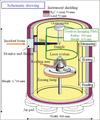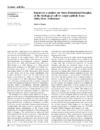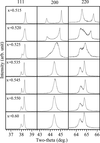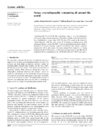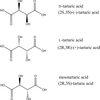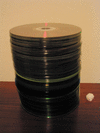issue contents
January 2008 issue
60 years of Acta Crystallographica and the IUCr
Guest Editor: Henk Schenk

Cover illustration: Two-dimensional image of a yeast cell. Hue represents the phase and brightness represents the amplitude of the X-ray exit wave. See Sayre [Acta Cryst. (2008). A64, 33–35].
feature articles
Free 

The state of the art of structure research on quasicrystals is reviewed. Some questions concerning formation, growth and stability are addressed.
Free 

Several results from neutron protein crystallography relating H-atom positions and hydration patterns in proteins and oligonucleotides are reviewed.
Free 

The paper highlights some of the extra difficulties involved in the measurement, interpretation and analysis of diffuse scattering relative to the methods of conventional crystallography and plots the progress that has been made in the lifetime of Acta Crystallographica. With the advent of the latest X-ray and neutron sources, area detectors and the ever-increasing power of computers, most diffuse scattering and disorder problems are now tractable.
Free 

In biocellular imaging, unwanted changes in the specimen during the longer exposures for three-dimensional data collection are making the step from two- to three-dimensional imaging difficult. Low-exposure stereoscopic three-dimensional imaging may be one answer to the problem.
Free 

A broad perspective on the techniques used by the coherent X-ray diffraction microscopy community is provided as an addendum to the paper by Sayre [Acta Cryst. (2008), A64, 33–35>].
Free 

The journal publishing activities of the IUCr over the past 60 years are described, together with the new technological, economic and cultural challenges faced by the journals. Particular emphasis is placed on the role of innovative publishing technologies in ensuring the quality of the published information and in providing effective access to the data underpinning the scientific results.
Free 

Structure determination from powder diffraction data has developed in the past decade to the stage where the structures of many molecular materials, particularly of pharmaceutical interest, are successfully solved. The intrinsically higher symmetry and more complex topology of inorganic materials complicate their structure determination from powder diffraction data which is, as a result, less routine than its molecular counterpart. The study of small proteins from powder diffraction data alone shows great promise and the first structures have been solved. The limits of the powder diffraction technique remain to be explored, particularly if auxiliary techniques are used.
Free 

The history of crystallographic computing and use of crystallographic software is one which traces the escape from the drudgery of manual human calculations to a world where the user delegates most of the travail to electronic computers. This review traces the development of small-molecule single-crystal and powder diffraction hardware, starting with the use of Hollerith tabulators of the late 1930's through to today's use of high-performance personal computers. It also emphasizes that the main challenge for current and future crystallography computing is not that of hardware development, or even specific scientific challenges, but rather in maintaining a critical mass of human expertise with which these computational challenges can be undertaken.
Free 

Since 1971, the Protein Data Bank archive of biological macromolecules has been a community-driven resource for science and education worldwide.
Free 

A survey of some of the main topics of mathematical crystallography is presented, together with the challenges for future developments.
Free 

The SHELX programs for crystal structure determination are reviewed by their author.
Free 

The current state of the charge flipping algorithm is reviewed.
Free 

The history and development of high-pressure crystallography are briefly described and examples of structural transformations in compressed compounds are given. The review is focused on the diamond-anvil cell, celebrating its 50th anniversary this year, the principles of its operation and the impact it has had on high-pressure X-ray diffraction.
Free 

Different techniques for structure determination from transmission electron microscopy and electron diffraction are reviewed, including three-dimensional reconstruction, the precession technique and ultrafast electron crystallography. Examples of electron-crystallography applications are given.
Free 

An innovative non-destructive method is presented for determining the chemistry of Na-pyroxene isomorphic mixtures characterizing Neolithic greenstone implements which permits their provenance and some of the prehistoric trade routes to be traced.
Free 

The last 10 years have seen a revolution in powder crystallography; macromolecules can now be studied using powder samples. When large single crystals are not available then crystallographic information may be obtained from a polycrystalline powder instead.
Free 

Originally conceived for protein crystallography, contrast variation has become a favourite tool of small-angle scattering. Recent developments in contrast variation are reviewed.
Free 

An overview of the recent discoveries of the monoclinic phases in the Cm and Cc space groups and their stability fields in the Pb(ZrxTi1−x)O3 phase diagram is presented.
Free 

The severe acute respiratory syndrome (SARS) coronavirus outbreak in 2003 had profound social and economic impacts worldwide. This review highlights the importance of structural biology and shows that structures for drug design can be rapidly determined in the event of an emerging infectious disease.
Free 

Crystallographic Nexus CD-ROMs, containing a range of free crystallographic software for single-crystal and powder diffraction available on the Internet, have been distributed free on request since 1996. The free CD is made in the form of a `virtual Internet' with the main intent of benefiting crystallographers with inadequate Internet access.
Free 

A concise review of the retrospect and prospects of high-pressure diffraction studies of organic crystals, with a special emphasis on pharmaceuticals and biomimetics.
Free 

The role played by the MEM/Rietveld method, which is a combination of the maximum-entropy method (MEM) and Rietveld analysis, for charge-density studies is described in the structural materials science of novel nano-materials. The atoms' and molecules' charge densities inside the nano-scale spaces of fullerene cages and metal-organic coordination polymers are visualized by using synchrotron-radiation powder data.
Free 

How tartaric acid, an inconspicuous organic compound found in wine, made a pivotal contribution to structural chemistry and biology.
Free 

A review of crystal-structure determinations of photo-induced molecular species, as derived using small-molecule single-crystal X-ray crystallography, is presented. Such species may be stable or transient, down to picoseconds, and are of substantial interest to the photonics industry.


 journal menu
journal menu










